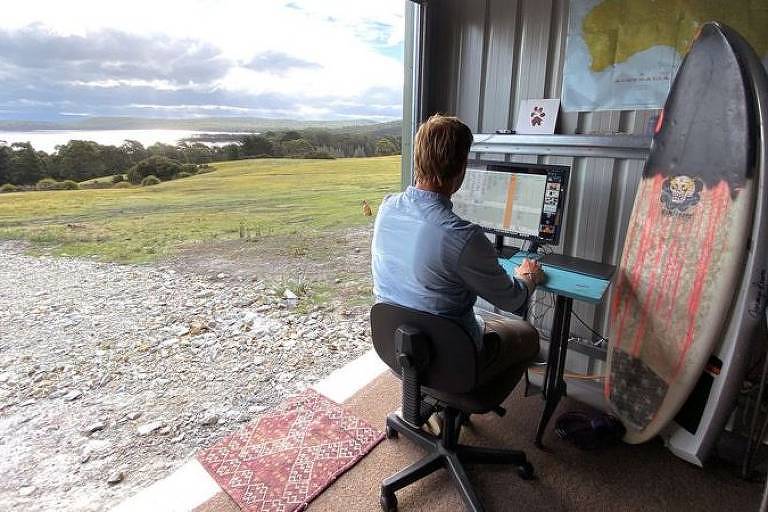How your home influences your home office productivity
The quality of space influences the experience of working from home
When Chris Scott wakes up in his new home on Bruny Island, on the southeastern coast of Tasmania, Australia, he usually walks five minutes to the sea to surf for an hour.
Then, the 38-year-old professional goes to the garage that he converted into a home office to face a full day's work as a senior project manager at Origin Energy.
Between video calls with his 20-person team, he strolls across the 50-acre estate to air his head - and may even end the day's work by diving with his wife in search of abalones, a type of mollusk, for dinner.
It is very different from the life he had in Sydney over the decade leading up to the Covid-19 pandemic, in which he needed to be in person from 9 am to 5 am.
"I am much more focused on my work here, much more productive ," he says of the move to Bruny Island in October.
"When I want to take a break, I feel like I'm really taking a break when I can hang up. So I have a lot more mental clarity."
For anyone in Scott's situation, the sudden move to work from home was a very positive experience.
But, for those with different living conditions, it has been a much greater challenge.
A recent study by Stanford University in the USA, for example, showed that only 49% of American professionals log in remotely from a dedicated work space, while the remaining 51% work in the bedroom or in a common area of the home.
The size and location of the space - as well as who you share it with - plays a significant role in determining how well you are able to work from home during the pandemic.
And it helps to explain why perceptions of the experience of remote work as a desirable option now vary widely according to age, sex and socioeconomic class - and can help shape our hybrid work future.
SPACE IS A LUXURY
In the initial effort to migrate to remote work, we turned to immediate problems - like working without a proper desk, placing a laptop at the right time, inserting entire companies on Zoom.
These short-term problems may be resolved, but thinking about broader factors takes more time; how, for example, the quality of our work environment determines how well we feel and the chance of wanting to continue like this.
Tiffany Philippou, 32, who lives in North London, has a home office experience very different from Scott's in Tasmania.
The communications and brand strategist has been working hard to answer customer calls and record her podcast, "Is This Working", from the small two-bedroom apartment she shares with a colleague who works in advertising.
The wi-fi is only strong enough to make video calls in the living room and in one of the bedrooms, so the pair have to do a daily chair dance, working on the kitchen table or on the folding desks in their walled rooms. thin as they adapt to each other's unpredictable schedules.
"Having to move in a small space and dealing with other people in this kind of fake office environment in your home is very exhausting," she says.
"Your brain can only handle a number of decisions every day, and the more you need it, the less energy and capacity it has for other things."
Philippou says he saw a growing disconnect between younger and older professionals.
"I think there is this gap, where managers and bosses who have a good home office are not realizing how mentally challenging it is for younger or less affluent people who need to share space in this new work context."
The generation of millennials has historically been seen as the most enthusiastic about remote work. However, recent research suggests that they may be facing more difficulty today than previous generations.
A global study of 12,000 employees, managers, HR leaders and C-level executives at the technology company Oracle showed that 89% of people aged 22 to 25 and 83% of people aged 26 to 37 said that had more stress and anxiety this year than before, as work problems extended into personal life due to lack of barriers.
This compares to only 62% of people aged 55 to 74.
Another study of 2,300 remote American employees at the Gensler Research Institute showed that, despite the technological readiness for mobile work, Generation Z and millennial professionals were much less likely than baby boomers to have a sense of accomplishment in the workplace. end of the day, or even complete daily tasks.
About 50% of Generation Z and Generation Y professionals found it more difficult to avoid distractions (compared to 33% of baby boomers), while 37% found it difficult to maintain a work-life balance (compared to 25% baby boomers).
"It is a real problem for younger professionals who have no peace at home because managers just expect you to go ahead, but if you don't have any space, how can you work?" asks Nicholas Bloom, professor of economics at Stanford University.
Last year, he conducted a survey of 2,500 American professionals to see how often they would like to work from home after the pandemic is over.
"About a quarter of people don't really want to work from home in the post-pandemic era, and they are mostly young and single in small apartments," he explains.
"Another one-quarter wants to work from home forever; they tend to be older, married, have children and live in homes."
THE ROLE OF SOUND
Kati Peditto, an environmental design psychologist at the United States Air Force Academy, says that, regardless of age, there are a number of important environmental factors —— both behavioral and physical that can play an important role in job performance and satisfaction. .
"Sound is important because it really highlights many of the inequalities we see in terms of remote work and productivity," she says, noting that non-white, lower-income individuals live disproportionately in places with higher noise levels.
Sound also comes into play when children are involved. Having children at home can lead to what Peditto calls a "distraction from responsibility", which studies show has a much greater impact on women than men who work from home.
"Individuals who have the luxury of having separate offices with doors that can close, or those who can afford a daycare or nanny, will do better in terms of productivity ," she says.
Creating a separate workspace was the solution that worked for Jo van Riemsdijk, co-founder of recruitment agency CX Talent, who lives in Hertfordshire, England, with her husband and two children.
When the pandemic forced everyone to work and study in the same house, with integrated rooms, they built a 3.9 square meter office in the soundproofed garden and heated floor.
"For me, these five steps to the office really help to create a border between work and home", explains the 48-year-old professional.
"My productivity and concentration are much higher than in my house because there is a lot of natural light, it is acoustically pleasant and there are no distractions, except, perhaps, a flying bird."
SPACE INVASION
There may also be a psychological advantage to having a dedicated workspace, separate from your personal space.
Before the pandemic, the office functioned as a neutral area with a uniform aesthetic in which everyone had access to the same resources.
But now the process of inviting colleagues into your home via video calls can allow you to analyze your own physical environment, which can be difficult for those who don't have a perfectly organized shelf to place behind the webcam.
"Instead of being judged by our physical appearance and professionalism - the clothes we wear, how well looked after we are - suddenly, you see what equipment you have, what is the definition of your camera, what is the clarity of your microphone, how is the lighting in your office, and you don't even have a home office, explains Peditto.
Videoconferencing also breaks down long-standing barriers between professional and personal life, making workers vulnerable to explicit and implicit comparisons of their workspaces - something you may feel more intensely working from the bedroom than from a garden office. .
Bloom, from Stanford, points out that before the pandemic, those who worked from home opted for this - and says that issues regarding privacy, space, choice and children are the four main factors that make the current experience of remote work unique.
With a large portion of the global workforce forced to work from home, he believes that much remains to be learned about the domestic conditions that make some prosper and others fail.
"When I talk to companies about who is coming back to the office, one of the big factors is: 'Which home environment is the most problematic?'", He says.
"Before Covid, the rule used to be that you would have to have your own exclusive space during the day, so you shouldn't be working from the bedroom because employers knew it was a mental health problem. Now, that is and we are seeing its consequences."
Bloom views the post-pandemic work model more as a hybrid plan, in which those who can work from home will do it about two days a week, on the same days as other members of his team.
It is basically a concession - a happy medium to please those who enjoyed the remote work experience and those who are counting the days to see his stall again.


No comments:
Post a Comment